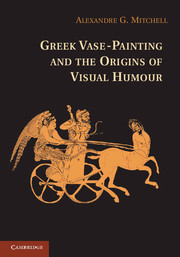Book contents
- Frontmatter
- Epigraph
- Contents
- List of Illustrations
- List of Tables
- Preface
- Acknowledgements
- Abbreviations
- GREEK VASE-PAINTING AND THEORIGINS OF VISUAL HUMOUR
- One Introduction
- Two Humour in the City
- Three Humour in the City
- Four Satyrs and Comic Parody
- Five Caricatures inAthens and at the Kabirion Sanctuary in Boeotia
- Six Conclusion
- Glossary
- Bibliography
- Index of Vases Cited in the Text
- General Index
Five - Caricatures in Athens and at the Kabirion Sanctuary in Boeotia
Published online by Cambridge University Press: 05 January 2014
- Frontmatter
- Epigraph
- Contents
- List of Illustrations
- List of Tables
- Preface
- Acknowledgements
- Abbreviations
- GREEK VASE-PAINTING AND THEORIGINS OF VISUAL HUMOUR
- One Introduction
- Two Humour in the City
- Three Humour in the City
- Four Satyrs and Comic Parody
- Five Caricatures inAthens and at the Kabirion Sanctuary in Boeotia
- Six Conclusion
- Glossary
- Bibliography
- Index of Vases Cited in the Text
- General Index
Summary
Autres temps autres moeurs. We have seen in Chapter 2 that the mocking of reprehensible social behaviour is a form of moral criticism, and it can be considered as a caricature of the soul; the exaggeration of gluttony is a leitmotif in caricature. In a similar way, in archaic and classical Greece, old age, pygmies, and dwarfs aroused laughter. Anything contrary to the norm was ridiculed. This chapter focuses first on caricature in Athens and then at the Kabirion sanctuary in Boeotia.
Dwarfs, an Introduction
Dasen’s book (1993) on dwarfs in ancient Egypt and Greece focuses on both the medical and the archaeological aspects of the condition. Most authors who examine dwarfs, or who concentrate on disability, deformity, or diseases in antiquity, are mainly interested in icono-diagnosis, that is, how much art can tell us about diseases and disabilities in the ancient world. My starting point is different: I am interested in representations of dwarfs in Greek vase-painting in comparison to ‘normal’ citizens, and how they were mainly used in caricature. In Greek art, dwarfs are persons of abnormally short stature and disproportioned bodies. Aristotle, who was somewhat interested in dwarfs (Somn. 3.457a 23–5; Hist. an. 6.24.577b 27–8; Part. an. 4.10.686b; 3.687b 25; 12.695a 8; Gen. an. 11.710b 13), categorizes them as ‘monsters’ because of the excessive development of the upper part of their body compared to their lower part. With their short legs, they resemble children, but they remain disproportioned throughout their lives (Louis 1975: 281).
- Type
- Chapter
- Information
- Greek Vase-Painting and the Origins of Visual Humour , pp. 235 - 279Publisher: Cambridge University PressPrint publication year: 2009

